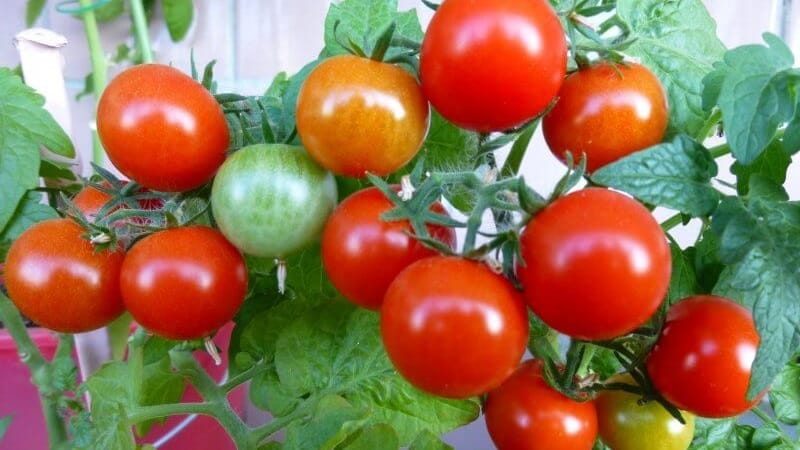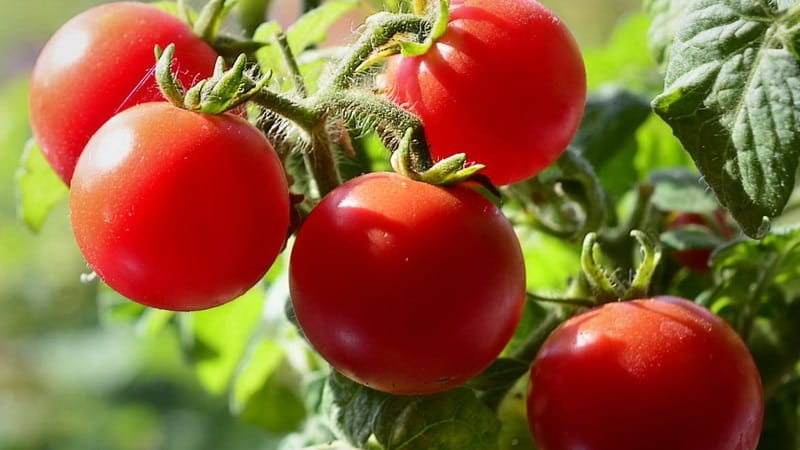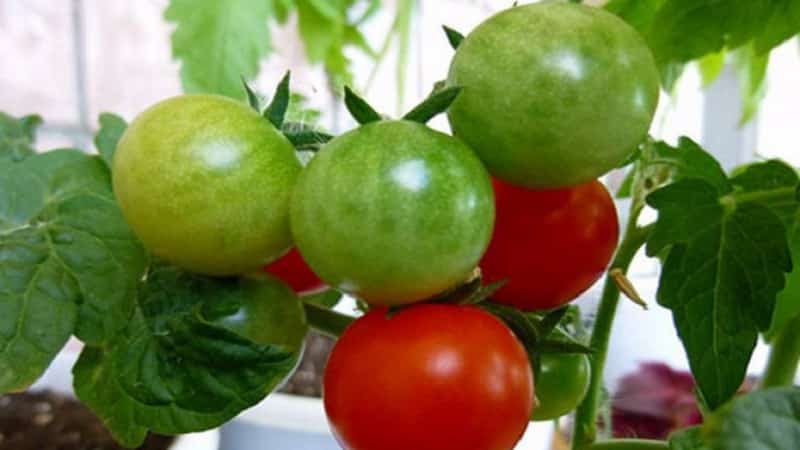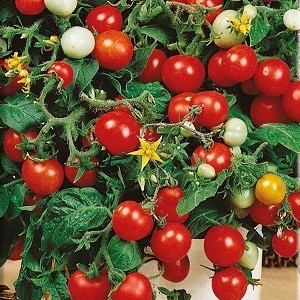Bright beads on the bushes - miniature tomato “Pinocchio”: we grow it on the plot and on the balcony at home
Cherry tomatoes are especially popular. They have a bright taste and a rich composition, in which the concentration of nutrients and vitamins is greater than in large fruits. Therefore, gardeners are increasingly growing cherry tomatoes on their plots.
If you live in an apartment and do not have your own summer cottage, this does not mean at all that you will not be able to grow tomatoes. Breeders have developed many dwarf varieties and hybrids that grow and ripen well in pots. One of them is the Pinocchio tomato. Read on to learn how to care for this crop on your windowsill and in your summer cottage.
Description of the variety
The Pinocchio tomato is a dwarf tomato variety. Its small growth allows it to be grown not only in the country, but also on the windowsill and balcony. At the same time, it is possible to obtain a large harvest of cherry tomatoes.
Features of Pinocchio
The main feature of the Pinocchio variety is its dwarfism. Thanks to this, the tomato has a decorative appearance. Make sure of this by looking at the photo.
This is interesting! The Pinocchio tomato is often grown in flower beds. At the moment of fruit formation, the bushes look very decorative. Their greenery is almost invisible under a large number of beaded fruits.
The fruits are juicy, but not watery. They contain an increased concentration of nutrients. 100 g of Pinocchio tomatoes contain the daily dose of iron, potassium, vitamins B, C and A necessary for a person.

Characteristics of a dwarf tomato
Growing a tomato is not difficult.It is easy to care for.
Description and characteristics of the Pinocchio variety:
| Parameter | Indicators |
| Bush type | determinant. Growth stops as soon as the superior ovary is formed. The maximum height of the plant is 40 cm. The bushes are strong, well-leafed, and shaped like a ball. The leaves are dark green, tomato-potato in shape. The root system is weak |
| Growing method | Suitable for growing in greenhouses and unprotected soil. Can be planted in boxes and flowerpots |
| Productivity | high - 1-1.5 kg of crop is harvested from one bush. Indicators decrease when growing tomatoes in pots. Up to 10 bushes are planted per square meter, so from 1 sq. m get up to 12 kg of fruit |
| Fruit | Pinocchio tomatoes are miniature in size. The maximum weight of one fruit of regular round shape is 40 g. There is no ribbing at the base. The taste of the fruit is pronounced sweet, with a slight sourness and a fruity aftertaste. Inside there are 2-3 chambers with small seeds. Fruits are formed in clusters, 10 pieces on each |
| Transportability | high - the skin of tomatoes is very strong, glossy and thin. Can be stored for up to a month |
| Ripening time | mid-season variety - the fruits ripen 90 days after seed germination. All Pinocchio tomato berries ripen almost simultaneously. After all the tomatoes are ripe, the bush dies |
| Disease resistance | has high immunity to all tomato diseases. Thanks to its early ripening, it is not even affected by late blight. |
Note! In the Russian register, Pinocchio is recorded as a mid-season variety. But many manufacturing companies position it as an early ripening crop. The fruits ripen within 90 days after emergence.
Rules for growing seedlings
Like other tomatoes, Pinocchio is grown in seedlings. Even when cultivating tomatoes on a windowsill, you cannot sow the seeds immediately into a large container. This will negatively affect their productivity.
Seeds are sown 60 days before the intended planting of seedlings in the ground. Therefore, preparatory work begins in the first half of May.
When growing tomatoes on a windowsill, the seeds are planted at any time of the year. At home, the plant is grown even in winter.

Preparation of planting material
According to gardeners, Pinocchio seeds have almost one hundred percent germination rate. Despite this, a number of preparatory work is carried out before sowing.
To test the seeds for germination, they are soaked in saline solution for half an hour. The floating planting material is removed, and the material that has sunk to the bottom is washed and used for planting.
Some manufacturers treat planting material with a disinfectant. Such seeds painted green or orange. If the seeds have not undergone this treatment, they are soaked for half an hour in a light pink solution of potassium permanganate.
Before planting, planting material is treated with a growth stimulator. Pieces of gauze are soaked in the solution, after which the seeds are wrapped in them. The time for seed treatment depends on the instructions for use of the product.
The most popular growth stimulants:
- "Epin";
- "KKM-1";
- "Zircon".

Choosing a container and soil for growing Pinocchio
For sowing, use large plastic trays, wooden boxes or homemade containers. If you plan to grow several plants at home, it is more convenient to use peat tablets.
To plant seedlings into individual containers, small containers are used.For example, peat or plastic pots, disposable cups or cut-off bottles.
To grow adult bushes on the windowsill and balcony, use pots or flowerpots. Their volume must be at least 2 liters. It is possible to plant adult plants in wooden boxes - no more than 10 tomatoes per 1 square meter. m.
There are many options for preparing soil for growing tomato seedlings. The best of them is considered to be a mixture of turf, peat and humus taken in equal parts. For each box of earth, add a glass of ash.
The soil mixture and containers for tomatoes are disinfected - calcined in the oven or poured with boiling water.
Sowing seeds
In the prepared soil, grooves are made 1 cm deep. The distance between them should be at least 3 cm.
Seeds are placed in the grooves at a distance of 2 cm from each other, covered with earth on top. The soil cannot be compacted.
The earth is moistened with a spray bottle. Cover the container with film and place in a warm place. Watering is not necessary until the planting material germinates.
Seedling care
Caring for Pinokkio seedlings must comply with all basic rules. There are not many of them, but they are very important:
- After germination, the seeds are moved to a well-lit place. If there is not enough light, then fluorescent lamps are used.
- The film is removed a week after the seeds have grown. Plants do well at room temperature.
- Before picking, water the plants using a pipette or syringe. When the tomatoes are transplanted into separate pots, use a watering can. The water should be warm and settled.
- When picking tomatoes, it is important not to damage the roots. The root system of Pinocchio tomatoes is weak, so it is impossible to break off a third of their central root.
- The seedlings are fed with complex fertilizers containing phosphorus. The first time fertilizer is applied 14 days after picking the plants, the next time after another 2 weeks, and the last time 3 days before transplanting the tomatoes to a permanent place.
- Tomatoes are hardened two weeks before transplanting into open ground. To do this, they are taken out into the fresh air, gradually increasing the time spent outside.

How to grow tomatoes
Pinocchio tomatoes are planted in a permanent place in the second half of May. They are grown both in open and closed ground.
Some gardeners do not plant dwarf bushes in separate beds, and they frame areas with other varieties of tomatoes or flower beds. Due to their low growth, they do not interfere with the growth of other crops. This variety is also grown in flowerpots in front of the house.
Planting seedlings in the ground
The land for growing tomatoes has been prepared since autumn. It is dug up and enriched ash, humus. All remains of weeds and cultivated plants are removed.
In spring, the soil is dug up again and disinfected. To do this, water the soil with a weak solution of potassium permanganate.
Before planting in a permanent place, the seedlings are watered and feed. This is done 2-3 days before plant transplantation.
On the day of planting, holes are dug into the ground. It is recommended to place 7-8 holes on one square meter. Some gardeners practice more dense planting, placing 1 sq. m. up to 10 plants.
A tablespoon of ash is poured into the bottom of each hole. Plants are placed there. There is no need to deepen the bushes.
Warm water is poured into each well. The depressions are filled with soil.

Plant care
To get a rich harvest, it is important to follow all the rules for caring for tomatoes. The most important of them:
- Plants do not need to be pinched or shaped.A bountiful harvest is obtained precisely due to the large number of ovaries. Once a week, remove yellowed leaves from the bush.
- Water the tomatoes as the soil dries out. Usually do 2-3 waterings per week. Moisten the soil in the afternoon.
- Tomatoes need to be fed regularly. The first time fertilizing is applied 3 weeks after planting the plants in the ground. Then the tomatoes are fertilized every two weeks until the first inflorescences form. Experienced gardeners advise alternating mineral compositions and mullein solution. It is also useful to use foliar feeding when the first ovaries appear.

Nuances of caring for tomatoes
When growing dwarf tomatoes, consider a number of features. The tips presented in the list will help you avoid some mistakes and grow healthy plants:
- Tomatoes are susceptible to loosening the soil. This procedure improves root air exchange. Do this after each watering. During the loosening process, it is important not to damage the roots.
- Tap or well water is not suitable for watering tomatoes. Before using the water, it should sit for at least a day.
- The Pinocchio tomato does not tolerate moisture on its greens. Therefore, the bushes are watered from a watering can directly under the root.
- Pinocchio's root system is weak, so weeds easily damage it. To prevent this from happening, weeding is done at least once a week.
Diseases and pests
Pinocchio is a variety that is resistant to all tomato diseases. Thanks to the short growing season and early ripeness, it does not even get sick late blight. Therefore, the only preventive measure it needs is to treat the seeds and soil with a disinfectant solution.
Tomatoes can be attacked by pests. Aphids, slugs, and the Colorado potato beetle appear on the bushes. The roots are damaged by the mole cricket and the larvae of the cockchafer.
All harmful insects are removed manually. To prevent their appearance on the bushes, tomatoes are treated with a soap solution or a decoction of chamomile and celandine. It is important that such products fall on the greenery and not on the soil.
To prepare a soap solution for spraying tomatoes, rub a piece of laundry soap into a bucket of water. When the soap crumbs dissolve, the product can be used.
Features of growing tomatoes in a greenhouse and open ground
When growing Pinocchio in a greenhouse, there are usually no difficulties with care. The only advice regarding this method of planting is that greenhouses need to be ventilated daily.
There are more difficulties in open ground. In the first week after transplanting into the soil, the seedlings are covered with film at night. In such conditions, it is necessary to mulch the beds, which will protect the bushes from pests and freezing.
When planting tomatoes on a balcony or windowsill, you need to use pots of at least 2 liters. The bushes are watered daily with a small amount of liquid. You will also have to loosen the soil every day.
In winter, tomatoes lack sunlight. Therefore, you need to use fluorescent lamps.
It is important! Pinocchio tomatoes have a short growing season. They begin to wither as soon as all the fruits ripen. After harvesting, old plants are replaced with new ones.
Harvesting and application
Pinocchio tomatoes ripen in early July. All the fruits on the bushes will ripen almost simultaneously.
The fruits are arranged on clusters of 8-10 pieces. You need to pick off the whole brush at once.
Tomatoes are best stored on the trusses.They are placed in the refrigerator in individual plastic containers.
Pinocchio tomatoes are suitable for fresh consumption and conservation. Due to their concentrated flavor, they are often used for drying. Therefore, from a gastronomic point of view, the variety is considered universal.
Advantages and disadvantages of the variety
 Pros of the Pinocchio variety:
Pros of the Pinocchio variety:
- precocity;
- high productivity;
- ease of care;
- the possibility of growing in open and protected ground, as well as on the balcony and windowsill;
- great taste;
- rich composition;
- versatility of crop application;
- uniform fruit ripening;
- resistance to diseases.
Disadvantages include a short growing season and a weak root system. No other disadvantages were identified in the variety.
Farmer reviews
Tomato Pinocchio has only good reviews. This variety surprises with its rich harvest and ease of care.
Alexandra Ivneva, Sochi: “I grow Pinocchio tomatoes in open ground. I plant them near beds of other varieties. They produce their harvest first and do not interfere with other plants. The fruits taste great and look great in salads.”
Ivan Karpov, Moscow: “I’ve always wanted to garden, but I don’t have my own summer cottage. Following recommendations from friends, I tried to grow Pinocchio tomatoes right on the windowsill. Now they harvest about a kilogram of delicious tomatoes from each bush all year round.”
Conclusion
The Pinocchio variety is a small cherry tomato growing on dwarf bushes. The height does not exceed 40 centimeters, so they do not need to be tied up or pinched. Their high immunity to disease also speaks in favor of these tomatoes.
Pinocchio is grown not only in suburban areas.Even residents of city apartments cultivate it. These tomatoes feel great in pots on the balcony and windowsill.